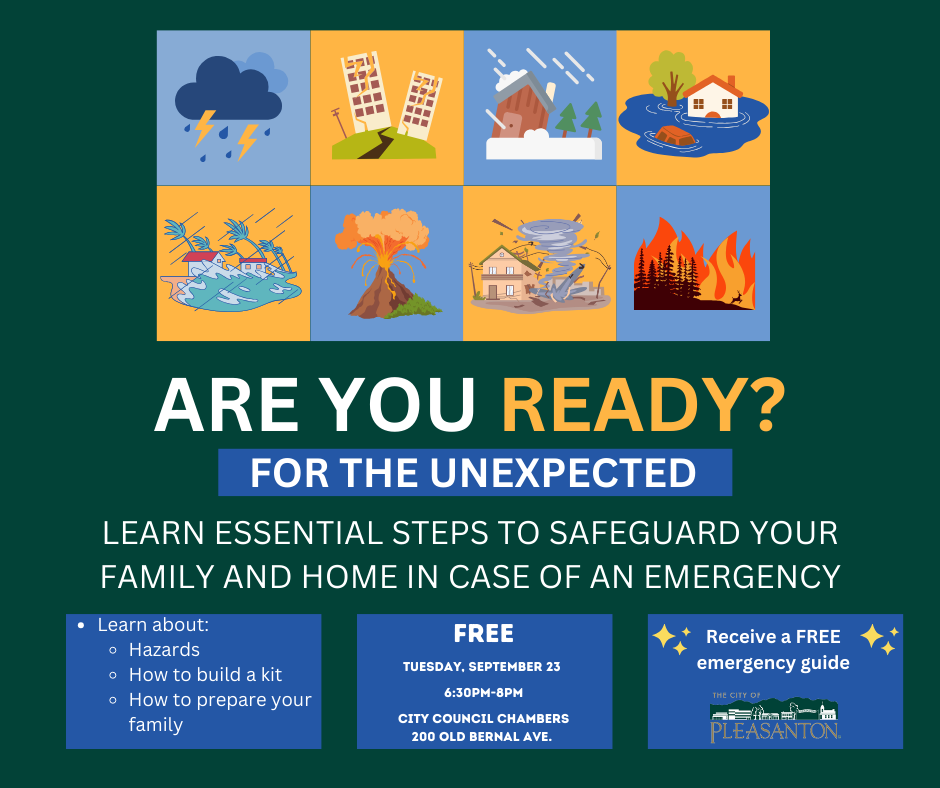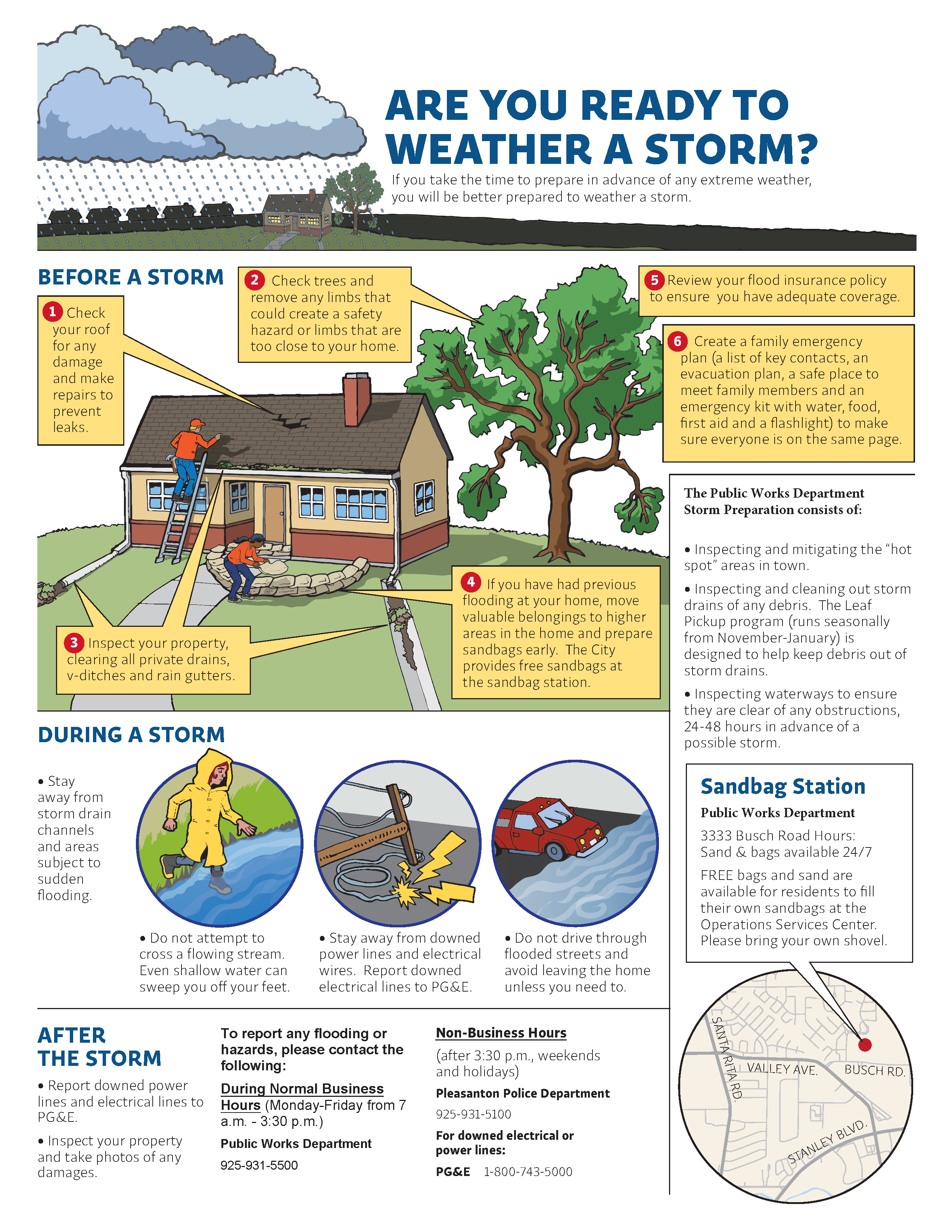Emergency Preparedness
Emergencies and disasters can strike anywhere and at any time. Emergency preparedness can bring you peace of mind. The resources below will help you and your family prepare, respond and recover from most emergencies and disasters.
Make a Plan!
Make a plan today. Your family may not be together if a disaster strikes, so it is important to know which types of disasters could affect your area. Know how you’ll contact one another and reconnect if separated. Establish a family meeting place that’s familiar and easy to find.
Step 1: Put a plan together by discussing the questions below with your family, friends or household to start your emergency plan
- How will I receive emergency alerts and warnings?
- What is my shelter plan?
- What is my evacuation route?
- What is my family/household communication plan?
- Do I need to update my emergency preparedness kit?
Step 2. Consider specific needs in your household
As you prepare your plan tailor your plans and supplies to your specific daily living needs and responsibilities. Discuss your needs and responsibilities and how people in the network can assist each other with communication, care of children, business, pets or specific needs like operating medical equipment. Create your own personal network for specific areas where you need assistance. Keep in mind some of these factors when developing your plan:
- Different ages of members within your household
- Responsibilities for assisting others
- Locations frequented
- Dietary needs
- Medical needs including prescriptions and equipment
- Disabilities or access and functional needs including devices and equipment
- Languages spoken
- Cultural and religious considerations
- Pets or service animals
- Households with school-aged children
Step 3: Create a Family Emergency Plan
Make a Family Emergency Plan quickly and easily with this fillable form.
Step 4: Practice Your Plan with Your Family/Household
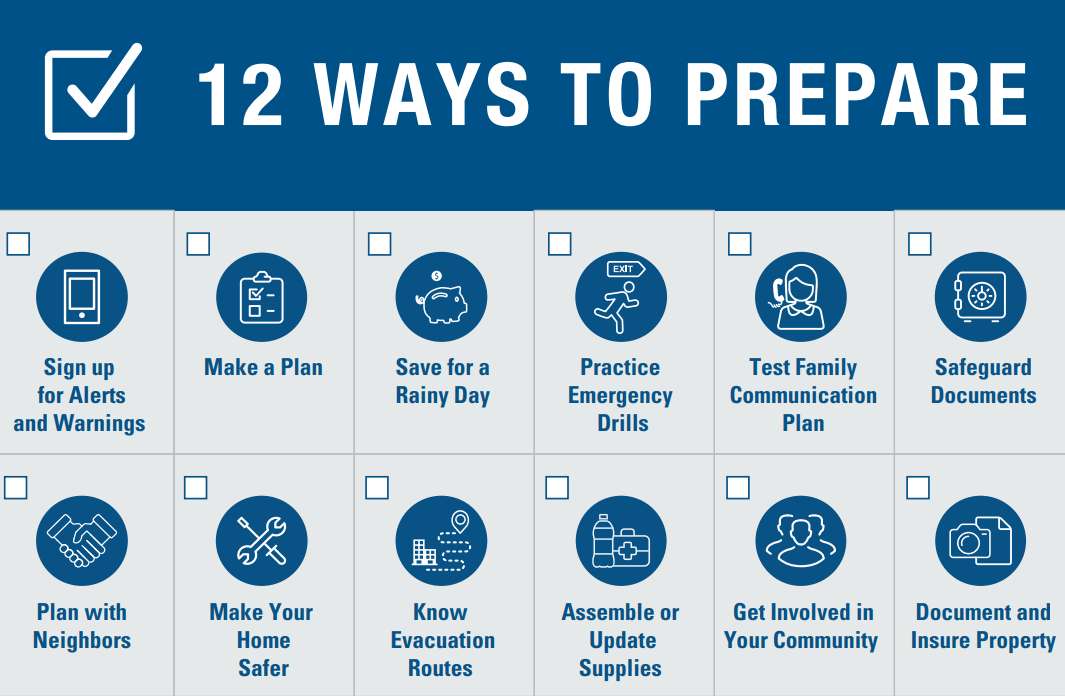
Emergency Alerts

AC Alert
This new service provides a way to quickly alert you in the event of a local emergency and is free to use. These alerts will provide important information you may need to keep you and your family safe.
Sign up for AC Alert through AC Alert – Public – Sign up (everbridge.net)
- Create your profile account as instructed.
- Enter how you want to be contacted, with phone numbers and/or emails.
- Enter your primary address and any additional addresses on which you want to be notified. Emergency alerts are sent based on the locations that you enter.
- In addition, you can subscribe for optional notifications from cities based on where you visit for work, or school, etc.
How AC Alert works
If there is a safety hazard or concern in your area, you will get a notification on whichever phone number or email you entered when you signed up.
Once you confirm that you have received the message, the system will stop trying to reach you. If you don’t confirm, the system will continue to try to reach you using all the contact numbers and emails that you provided.
You can update your information at any time. If you would like to stop receiving notifications, you can opt-out by removing your profile from the system.

Know Your Zone – Evacuation Resources
In the event of a wildfire or an emergency situation, law enforcement and fire agencies issue evacuation warnings or evacuation orders for impacted areas. These notices are issued for a Zone with an evacuation Status.
To check the status of your evacuation zone or turn on your location to get notified about danger wherever you are.
Visit genasys Protect website or download the Mobile App.

Everbridge/Nixel
Everbridge Nixle keeps you up to date with relevant information from local agencies. Get emergency alerts sent straight to your cell phone.
Don’t wait until it’s too late. Enroll today!
Text your Zip Code to 888777 or Sign Up Online
Earthquakes
Preparing for earthquakes is crucial in California. The City of Pleasanton wants you to be prepared.
Follow these simple steps before an earthquake occurs:
- Practice DROP, COVER, and HOLD ON at home and work
- Get life-saving seconds to stay safe before the shaking starts by downloading and setting up alerts from California’s Earthquake Early Warning System at www.earthquake.ca.gov
- Secure loose and tall furniture to minimize damage
- Have a Go-Bag and shoes in a place that you find quickly to evacuate.
Knowing what to do during an earthquake happens can save lives. Follow these simple steps during an earthquake:
- If inside, do not rush outside or stand in the doorway
- DROP, COVER and HOLD ON
- If in bed, stay there and COVER your head with a pillow
- If outdoors, move away from anything that can fall, especially power lines, trees, streetlights, and buildings
- If driving, pull over and set the parking brake. Make sure to stop away from trees, bridges, buildings and power lines.
Follow these tips for what to do after an earthquake occurs:
- Be ready for aftershocks over several days or weeks. Whenever you feel shaking, DROP, COVER and HOLD ON
- Visit www.pleasantonca.gov for reliable emergency information
- Check for hazards around you, including gas leaks, downed power lines, and ruptured pipes. If you smell gas, evacuate everyone immediately
- Do not enter damaged buildings. Wait for city staff to say it’s safe.

Cooling Facilities
In the summer, multiple days and nights of hot weather can be very dangerous. The City of Pleasanton has ways to help you cool down:
- Visit our library during its regular business hours:
Monday/Thursday 10am-6pm; Tuesday/Wednesday 1pm-9pm; Friday/Saturday 9am-5pm and Sundays Closed - In extreme heat watch for notices about official cooling center openings in Pleasanton. Check here for other cooling centers in the region.
- Remember to always follow these tips during extreme heat:
- Watch for signs of heat illness
- Keep cool/stay hydrated
- Look out for others.

PG&E Power Outages
Unfortunately, during warm weather, Pleasanton can see an increase in power outages. Below are a few tips that can help you stay prepared:
- If you use electronic medical and assistive devices, create a personal disaster plan with family and caregivers for how to meet your needs during a power outage
- Check PG&E’s website for outage information and estimated restoration times. For more information, visit the PG&E Outage Center and check the PG&E Outage Map.
- Get notified about Public Safety Power Shutoffs (PSPS). During a threat of extreme weather or wildfire conditions, PG&E may turn off power as a safety precaution. Sign up to receive alerts at www.acalert.org.
- Get flashlights or lanterns with extra batteries, and surge protectors for sensitive devices. Do not use candles or oil lanterns for light
- Keep phones and backup batteries fully charged
- Have access to a battery-powered radio for news
- Have freezer packs, ice and cooler ready to keep food and medicine cold
- If you have an electronic garage door, learn how to manually release the lever
- Know where your circuit breakers and fuse back are and how to check them
- Have phone numbers written down in case of an emergency .
During Power Outages:
Extended power outages may impact the whole community.
- Keep freezers and refrigerators closed
- Use a generator, but only outdoors and away from windows
- Do not use a gas stove or oven to heat your home
- Disconnect appliances and electronics to avoid damage from electrical surges
- Have alternative plans for refrigerating medicines or using power-dependent medical devices
- Check with local officials about heating and cooling locations open near you
- Report downed power lines to 911 and your utility. Keep pets and people away
- Turn off everything that was on before the outage. Leave one light on that you will see when the power is back
- Unplug sensitive electronic equipment if you do not have surge protectors
- Go to a community location, like the Pleasanton Library
- Check on your neighbors, especially the elderly or medically frail.
For more information visit Ready.gov
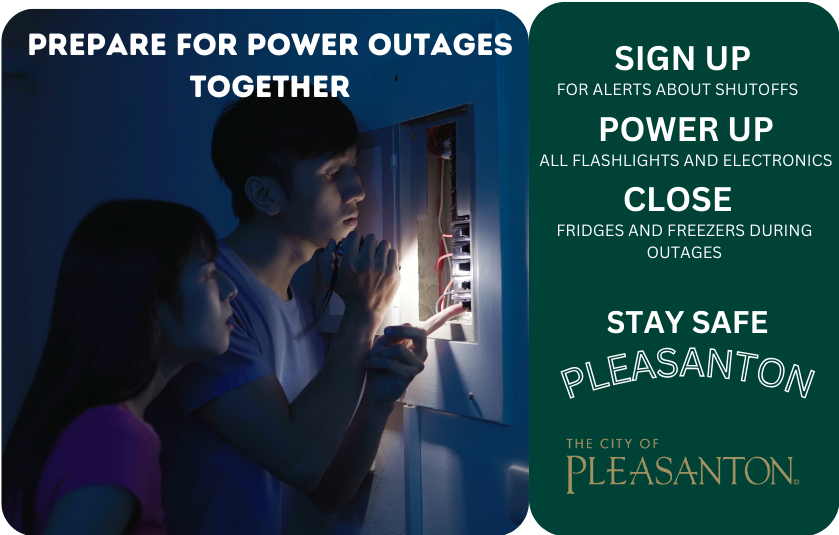
Wildfires
Wildfires are unplanned fires that burn in natural areas. These dangerous fires spread quickly and can devastate not only wildlife and natural areas but also communities.
Prepare for Wildfires:
- Sign up for community alerts and be aware of Emergency Alert System (EAS) and Wireless Emergency Alert (WEA), which require no sign up
- Make an emergency Plan
- Review important documents and save them in a secure password-protected digital space
- Strengthen your home
- Use fire-resistant materials
- Find an outdoor water source with a hose that can reach your property
- Create a fire-resistant zone that is free of leaves and debris
- Know your evacuation zone and learn your evacuation routes
- Gather supplies.
Stay Safe During a Wildfire:
- Pay attention to emergency alerts and notifications
- PayEvacuate immediately if you are told to do so
- PayUse an N95 mask to protect yourself from smoke inhalation
- PayCall 911 if you need immediate assistance
Returning Home After a Wildfire:
- Do not return home until authorities say it is safe to do so
- PayAvoid hot ash, charred trees, smoldering debris and live embers. The ground may contain heat pockets that can burn or spark another fire
- PayWear protective clothing during your cleanup efforts
- PayLimit your exposure outside as dust particles may be present
- PayDocument property damage with photographs
- PaySend text messages or use social media to reach out to family. Phone systems are often busy following a disaster.
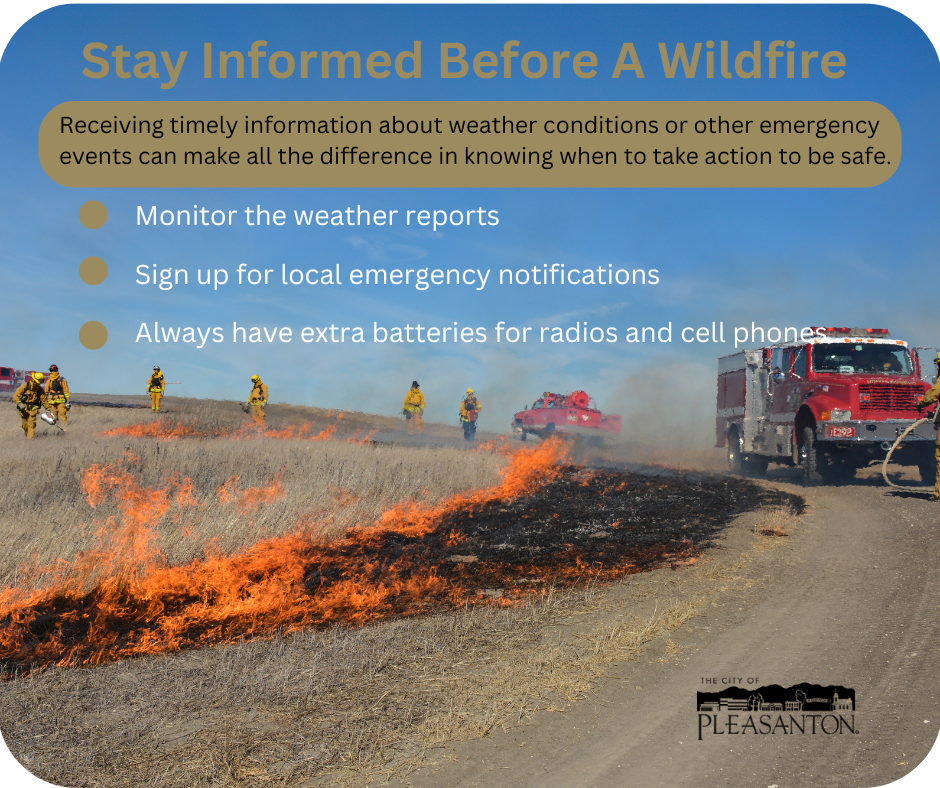
Winter Storm Preparation
Are you Ready to Weather a Storm?
The weather is unpredictable. Taking the time to prepare in advance of extreme weather, will prepare you to weather a storm.
Before a Storm
- Monitor current weather conditions
- Inspect your roof for any damage or leaks
- Inspect your property, clearing private drains, v-ditches and rain gutters
- Check trees and remove any limbs that look like they could create a safety hazard
- Cover toxic materials with tight-fitting lids and/or store them indoors
- If you have had previous experience with flooding at your home, move valuable belongings to higher areas in the home and prepare sandbags early. The City provides free sand and bags at 3333 Busch Road
- Review your flood insurance policy
- Create a family emergency plan.
During a Storm
- Stay away from storm drain channels and areas subject to sudden flooding
- Stay away from downed power lines
- Do not attempt to cross a flowing stream
- Do not drive through flooded streets.
After the Storm
- Monitor the weather and only leave your home if safe to do so
- Report downed power lines to PG&E
- Inspect your property and take photos of any damage.
For more information on how to prepare visit Ready.gov.
Flooding
For more information about flooding, sandbags, and additional resources, please visit the Floodplain Management page.

Livermore-Pleasanton
Fire Department
More information on how to be prepared in an emergency, CERT and Volunteer Opportunities can be accessed here:
Disaster Preparedness | Livermore-Pleasanton Fire Department

